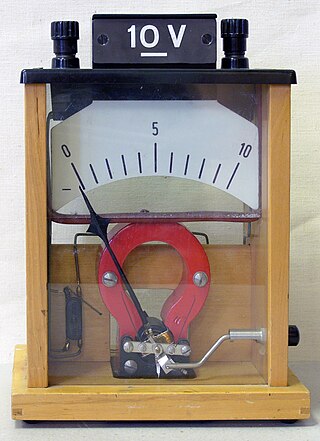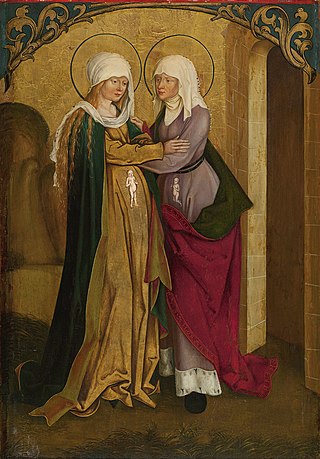
A digital synthesizer is a synthesizer that uses digital signal processing (DSP) techniques to make musical sounds. This in contrast to older analog synthesizers, which produce music using analog electronics, and samplers, which play back digital recordings of acoustic, electric, or electronic instruments. Some digital synthesizers emulate analog synthesizers; others include sampling capability in addition to digital synthesis.

A voltmeter is an instrument used for measuring electric potential difference between two points in an electric circuit. It is connected in parallel. It usually has a high resistance so that it takes negligible current from the circuit.

A digital elevation model (DEM) or digital surface model (DSM) is a 3D computer graphics representation of elevation data to represent terrain or overlaying objects, commonly of a planet, moon, or asteroid. A "global DEM" refers to a discrete global grid. DEMs are used often in geographic information systems (GIS), and are the most common basis for digitally produced relief maps. A digital terrain model (DTM) represents specifically the ground surface while DEM and DSM may represent tree top canopy or building roofs.

Topography is the study of the forms and features of land surfaces. The topography of an area may refer to the land forms and features themselves, or a description or depiction in maps.

An analogsynthesizer is a synthesizer that uses analog circuits and analog signals to generate sound electronically.

The Brandenburg Concertos by Johann Sebastian Bach, are a collection of six instrumental works presented by Bach to Christian Ludwig, Margrave of Brandenburg-Schwedt, in 1721. The original French title is Six Concerts à plusieurs instruments, meaning "Six Concertos for several instruments". Some of them feature several solo instruments in combination. They are widely regarded as some of the best orchestral compositions of the Baroque era.

In electronics, ring modulation is a signal processing function, an implementation of frequency mixing, in which two signals are combined to yield an output signal. One signal, called the carrier, is typically a sine wave or another simple waveform; the other signal is typically more complicated and is called the input or the modulator signal. A ring modulator is an electronic device for ring modulation. A ring modulator may be used in music synthesizers and as an effects unit.
Digital cable is the distribution of cable television using digital data and video compression. The technology was first developed by General Instrument. By 2000, most cable companies offered digital features, eventually replacing their previous analog-based cable by the mid 2010s. During the late 2000s, broadcast television converted to the digital HDTV standard, which was incompatible with existing analog cable systems.

The Yamaha DX7 is a synthesizer manufactured by the Yamaha Corporation from 1983 to 1989. It was the first successful digital synthesizer and is one of the best-selling synthesizers in history, selling more than 200,000 units.

A dashboard (also called dash, instrument panel (IP), or fascia) is a control panel set within the central console of a vehicle or small aircraft. Usually located directly ahead of the driver (or pilot), it displays instrumentation and controls for the vehicle's operation. An electronic equivalent may be called an electronic instrument cluster, digital instrument panel, digital dash, digital speedometer or digital instrument cluster.

A mixed-signal integrated circuit is any integrated circuit that has both analog circuits and digital circuits on a single semiconductor die. Their usage has grown dramatically with the increased use of cell phones, telecommunications, portable electronics, and automobiles with electronics and digital sensors.

In 1724 Johann Sebastian Bach composed the church cantata Meine Seel erhebt den Herren, BWV 10, as part of his second cantata cycle. Taken from Martin Luther's German translation of the Magnificat canticle, the title translates as "My soul magnifies the Lord". Also known as Bach's German Magnificat, the work follows his chorale cantata format.

Johann Sebastian Bach's Magnificat, BWV 243, is a musical setting of the biblical canticle Magnificat. It is scored for five vocal parts, and a Baroque orchestra including trumpets and timpani. It is the first major liturgical composition on a Latin text by Bach.

Heinrich Wild was a Swiss businessman, industrial designer, and inventor who was the founder of Wild Heerbrugg, a Swiss optical instruments manufacturing company.
Schloss Lieser in the Mosel valley nearby Bernkastel-Kues is one of the most striking buildings within the village of Lieser, Germany. The building currently houses a 49-room Autograph Hotel, called Schloss Lieser, Autograph Collection.
Tilge, Höchster, meine Sünden, BWV 1083, is a sacred vocal composition by Johann Sebastian Bach. It is an arrangement that Bach made in the 1740s of Pergolesi's Stabat Mater from 1736, slightly expanding the orchestral material. He used a German paraphrase of Psalm 51 as text for his composition. While Bach named the work a Motetto in the autograph, it is rather a psalm cantata, scored for soprano and alto voices, strings and basso continuo. Some of the 14 movements have become traditionally sung by a two-part choir. The work was first published by Hänssler in 1962, and in a critical edition, based on Bach's performance material found only later, by Carus-Verlag in 1989. The work is interesting to scholars as an example how Bach edited music from a different tradition.
Orel Ice Fringe is a strip of coastal ice in Antarctica in the Antarctic Peninsula along the Danco Coast, bordering the south side of Errera Channel between Beneden Head and Porro Bluff, on the west coast of Graham Land. Mapped by the Falkland Islands Dependencies Survey (FIDS) from photos taken by Hunting Aerosurveys Ltd. in 1956–57. Named by the United Kingdom Antarctic Place-Names Committee (UK-APC) in 1960 for Eduard von Orel (1877–1941), Austrian surveyor who in 1905 designed the first stereoautograph for plotting maps directly from horizontal photographs.

The Magnificat in E-flat major, BWV 243a, also BWV 243.1, by Johann Sebastian Bach is a musical setting of the Latin text of the Magnificat, Mary's canticle from the Gospel of Luke. It was composed in 1723 and is in twelve movements, scored for five vocal parts and a Baroque orchestra of trumpets, timpani, oboes, strings and basso continuo including bassoon. Bach revised the work some ten years later, transposing it from E-flat major to D major, and creating the version mostly performed today, BWV 243.

Abstract photography, sometimes called non-objective, experimental or conceptual photography, is a means of depicting a visual image that does not have an immediate association with the object world and that has been created through the use of photographic equipment, processes or materials. An abstract photograph may isolate a fragment of a natural scene in order to remove its inherent context from the viewer, it may be purposely staged to create a seemingly unreal appearance from real objects, or it may involve the use of color, light, shadow, texture, shape and/or form to convey a feeling, sensation or impression. The image may be produced using traditional photographic equipment like a camera, darkroom or computer, or it may be created without using a camera by directly manipulating film, paper or other photographic media, including digital presentations.
Performances of Johann Sebastian Bach's Magnificat come in three formats:
- D major version, BWV 243 with the twelve movements of that version;
- D major version, with the Christmas interpolations from the earlier version BWV 243a transposed and inserted after movements 2, 5, 7 and 9.
- E flat major version, BWV 243a. The difference with the previous format is not only the key signature, there are also differences in orchestration, e.g. in the earlier version flutes are not part of the tutti, so do not play in the choral movements 1, 7 and 12, and a trumpet solo in movement 10 instead of the later unison oboes. Other differences are minor, but there is for instance a slightly harsher harmony near the end of movement 4 in the earlier version.















